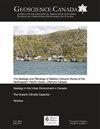火成岩协会29。Nenana磁铁矿熔岩流,阿拉斯加山脉,阿拉斯加
IF 0.8
4区 地球科学
Q3 GEOSCIENCES, MULTIDISCIPLINARY
引用次数: 0
摘要
像El Laco(智利)这样的磁铁矿矿床非常罕见,其成因也存在争议。阿拉斯加山脉中北部出现了一股不同寻常的磁岩熔岩流,覆盖着一个流纹岩单元,最初覆盖了中新世Nenana盆地的约750平方公里。流纹岩的年代测定以及磁铁矿和沉积岩之间的关系表明两者都属于中新世晚期。磁铁矿流主要为磁铁矿,喷发后有赤铁矿蚀变。流纹岩流和磁铁矿流都是泡状的,但磁铁矿流也有小的、毫米级的柱状节理。磁铁矿中的气孔带以薄片的规模分级为块状岩石,表明是脱气熔岩成因。磁铁矿流的样品含有12至26重量%的SiO2和45至75重量%的FeO。磁铁矿和流纹岩中的稀土元素(REE)和微量元素具有相似的模式,但在磁铁矿中的丰度较低。流纹岩和磁铁矿均具有轻REE富集REE剖面,具有负Eu异常。电镜分析表明,磁铁矿流中二氧化硅和微量元素的含量大部分来自磁铁矿中分布极细的硅酸盐矿物和玻璃。这表明,磁铁矿来源于岩浆,在喷发前已分解为富硅相和富铁相。磁铁矿流中的裂缝和囊泡含有少量的流纹岩玻璃和矿物,这表明流纹岩岩浆侵入了固化的磁铁矿流中柱状节理,并且在所研究的位置是一个次火山岩床状体。磁铁矿流在流纹岩侵位之前爆发,可能在区域范围内喷出。Nenana磁铁矿的特征及其地质关系与成因模型一致,该模型使岩浆在上升过程中分解成不混溶的富铁和富硅液体。本文章由计算机程序翻译,如有差异,请以英文原文为准。
Igneous Rock Associations 29. The Nenana Magnetitite Lava Flow, Alaska Range, Alaska
Magnetitite deposits like El Laco (Chile) are rare and have controversial origins. An unusual magnetitite lava flow overlying a rhyolite unit occurs in the north-central Alaska Range and originally covered ~ 750 km2 of the Miocene Nenana basin. Dating of the rhyolite and relationships between the magnetitite and sedimentary rocks indicate that both are of Late Miocene age. The magnetitite flow is mainly magnetite with some post-eruptive alteration to hematite. Both the rhyolite flow and the magnetitite flow are vesicular, but the magnetitite flow also has small, millimetre-scale columnar jointing. The vesicular zones in the magnetitite flow grade into massive rock on the scale of a thin section, suggesting a degassing lava origin. Samples of the magnetitite flow contain between 12 and 26 wt.% SiO2 and between 45 and 75 wt.% FeO. Rare earth elements (REE) and trace elements from the magnetitite and rhyolite have similar patterns but with lesser abundance in the magnetitite. Both the rhyolite and the magnetitite have light-REE-enriched REE profiles with negative Eu anomalies. Electron microscopic analysis shows that most of the silica and trace element content of the magnetitite flow comes from very finely disseminated silicate minerals and glass in the magnetite. This suggests that the magnetitite was derived from a magma that had undergone unmixing into a silica-rich phase and an iron-rich phase prior to its eruption. Fractures and vesicles within the magnetitite flow contain minor rhyolitic glass and minerals suggesting that the rhyolite magma invaded columnar joints in the solidified magnetitite flow, and is a subvolcanic sill-like body at the studied locality. The magnetitite flow erupted prior to the emplacement of the rhyolite, which may be extrusive on a regional scale. The features of the Nenana magnetitite, and its geological relationships, are consistent with genetic models that invoke unmixing of magma into immiscible Fe-rich and Si-rich liquids during ascent.
求助全文
通过发布文献求助,成功后即可免费获取论文全文。
去求助
来源期刊

Geoscience Canada
地学-地球科学综合
CiteScore
3.30
自引率
0.00%
发文量
9
审稿时长
>12 weeks
期刊介绍:
Established in 1974, Geoscience Canada is the main technical publication of the Geological Association of Canada (GAC). We are a quarterly journal that emphasizes diversity of material, and also the presentation of informative technical articles that can be understood not only by specialist research workers, but by non-specialists in other branches of the Earth Sciences. We aim to be a journal that you want to read, and which will leave you better informed, rather than more confused.
 求助内容:
求助内容: 应助结果提醒方式:
应助结果提醒方式:


